Innovation in Logistics
Innovation in logistics aims to increase productivity, competitiveness at both the firm and supplychain levels. The innovative activities undertaken in logistics align with the Organisation forEconomic Co-operation and Development's (OECD) definitions of the four types of innovation:organizational, process, marketing, and service.11 Industrial sectors and the logistics service industry are leaders in incorporating all four types of innovation into logistics practices.
Organizational innovation is the implementation of a new method in a firm's business practices,such as supply chain mandates, green supply chain management,Footnote L and new approaches to key performance indicator (KPI) measurement. Process innovation includes the implementation of new or significantly improved delivery methods, such as supply chain visibility, warehouse management system (WMS)Footnote M and transportation management system (TMS).Footnote N Linking logistics networks to CPFR is an example of marketing innovation in logistics, while service innovation is the introduction of a service that is new or significantly improved in its characteristics or intended uses. In logistics, this is demonstrated through the development and evolution of global trade management and e-business models. 2
Logistics innovation is at the forefront of global value chain network integration. Linking internalinformation systems such as enterprise resource planning (ERP), customer relationship management(CRM) and manufacturing resource planning (MRP) systems with supply chain partners(i.e. financial institutions, suppliers, customers and governments) results in an efficient, agile andcompetitive network (Figure 12).
Figure 12 — Logistics Innovation Footprint 2
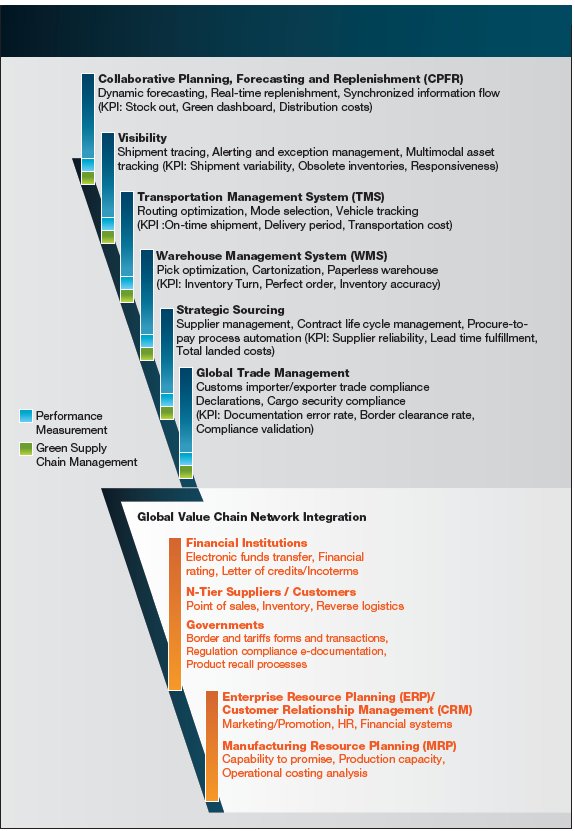
The use of KPI measurements that have been specifically developed and tailored for each level of an organization (executive, tactical, and operational) can enhance employee commitment to their role in an enterprise (Table 4). Using KPI measurements where workers have a direct impact is key. For example, metrics that focus on quality, such as achieving perfect orders and on-time shipments, are suitable KPIs at the operational level. Tactical-level KPI measurements should emphasize efficiency of operational activities, including inventory turnover and lead-time fulfillment. Finally, KPI measurements at the executive level should aim at enhancing business performance, with specific metrics such as total landed cost and return on investment. KPI measurements of organizational innovation extend beyond internal metrics to include value chain partners through supply chain mandates — more specifically, the use of KPI dashboards and reward systems. 2
Table 4
| Executive | Profitability and revenue KPIs (e.g., total landed cost, return on investment on innovation) |
|---|---|
| Tactical | Operational efficiency KPIs (e.g., inventory turn, lead time fulfillment) |
| Operational | Quality and service level KPIs (e.g., perfect order, on-time shipments) |
Manufacturing, retail, and natural resources industries are relying on logistics innovation andnetworks to deliver seamless, integrated, secure, reliable and efficient solutions to leverage theirglobal value chains (Figure 13). Canadian aerospace firms are shifting their priorities to improvingsupply chain agility and flexibility; for example, enhancing operational performance and shorteningcycle times were identified as top drivers for aerospace logistics innovation.12 Global trade management and the incorporation of CPFR concepts into their value chains are other key logistics developments taking place in this sector (Table 5).
Figure 13 — Introduction of new or improved logistics methods, by industry (2007 to 2009) 4
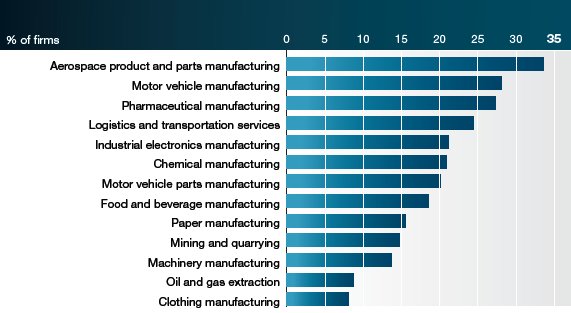
The pharmaceutical supply chain is implementing innovations in unit-level traceability and visibilityto improve response time, accuracy and overall efficiency of the supply chain while enhancingcompliance with industry and government regulations. 2
For Canadian automotive manufacturers, the implementation of just-in-time (JIT) and masscustomization processes have already led to greater supply chain agility; however, one keyimprovement is the integration of point-of-sales information into CPFR-based replenishment systems with auto assemblers and parts manufacturers. Meanwhile, logistics innovation by industrial electronics firms focuses on synchronizing products with trading partners via web-based catalogs and exchanging information, through visibility systems, on firms' capabilities to promiseFootnote O and deliver products. 2
Table 5
| Aerospace | Global trade management and incorporating CPFR concepts into value chains |
|---|---|
| Pharmaceutical | Unit level traceability and visibility to enhance compliance with therequirements resulting from industry and governmental regulations |
| Automotive | Integrate point-of-sales information into CPFR-based replenishment systems with auto assemblers and parts |
| Industrial electronics | Synchronise products with trading partners on web-based catalogs andexchange information through visibility systems on capability to promise and deliver products |
| Retailers and CPG manufacturers | Point-of-sales forecasting and data exchange and system compatibilitiesto enable visibility during transportation, and support linkages withCPFR systems |
| Resource based industries | Strategic asset location and global view on output with rail, marine andtrucking capacity and schedules, taking into account customer demand projections |
Retailers and CPG manufacturers have invested in data exchange and system compatibilities to enable visibility during transportation and support linkages with CPFR systems. These capabilities provide opportunities to initiate point-of-sales analyses to inform sales and replenishmentforecasts. Also, the adoption of alert-based supply chain event applications enables the rapidresolution of issues that may arise along the supply chain. 2
While the initial e-commerce model for retailers and manufacturers involved placing all productlines online, it now comprises a parallel operation that enables retailers to increase their marketcoverage beyond bricks-and-mortar locations. Today's e-commerce enables retailers and manufacturersto offer specialized products with high profit margins without disrupting the flow ofdistribution centres. Furthermore, e-commerce provides a channel to consolidate clearance itemsin one distribution centre while increasing product selection for consumers without exhaustingfloor space. 2
In the natural resources sector, innovative tools and practices in logistics permit the integrationof mining output with rail, marine and trucking capacity and schedules, taking into accountcustomer demand projections. By having a global view of network capacity, these industries areincreasing their service levels, competitiveness, productivity and opportunities to serve nichemarkets around the world.
Transportation and logistics providers are increasingly adopting advanced technologies and innovativeprocesses to retain their competitive advantage (Figure 14). These new methods have takendifferent forms by sub-sector. The shift to technological innovation had the greatest impact on 3PL firms with the introduction of WMS, which includes picking automation and carousel and pallet configuration optimization, and on couriers and messenger firms adopting visibility and web-based solutions for small shipments.2 Global trade management and web-based applications for users are two key innovations adopted by 4-5PL firms that have great potential to increase the efficiency of supply chains. 2
Figure 14 — Introduction of new or improved logistics methods by logistics and transportation service providers (2007 to 2009) 4
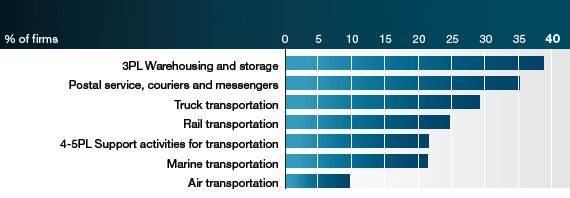
Demand and capacity management as well as multimodal modelling have improved efficiency in the rail industry. While measuring the carbon footprint of rail transportation does resonate with demands for more environmentally friendly freight options, the trucking industry is opting for green dashboards and route optimization to minimize trip times and energy consumption. Global trade management and visibility connected with government and port applications support compliance with international marine transportation regulations. Track and trace technologies are being readily adopted by air cargo providers that offer rapid service and carry high-value merchandise. 2
These innovations have also allowed logistics and transportation firms to respond to supply chainmandates with greater ease. As a result, close to 60 percent of logistics and transportation serviceproviders report that mandates have led to improvements in service quality (Figure 15). Mandateshave also resulted in cost reductions (55 percent of firms) by increasing on-time shipments and load fill, as well as route optimization and piggybacking with other customers. 2
Figure 15 — Logistics and transportation service providers' responses to customer mandates 4
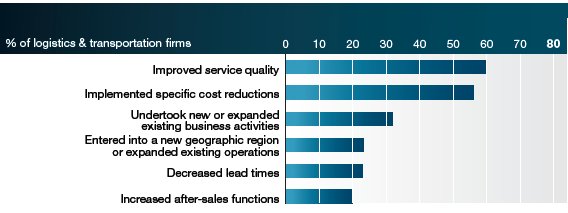
Advanced Technology Adoption
Three main types of advanced technologies have been adopted by logistics and transportationservices firms, namely, advanced communication, advanced information integration and control,and advanced computerized inspection technologies. The adoption rates, drivers and applicationsof each technology vary greatly between industries (Figure 16). Advanced communicationtechnologies are the most widely adopted across all sub-sectors. Postal services, couriers andmessenger firms are top adopters with 43 percent of firms, followed by marine transportation (39 percent) and 3PL warehousing and storage (36 percent). Between 15 percent and 25 percent of air, truck and rail transportation firms have also implemented these technologies. 4
Figure 16 — Advanced technologies adoption by logistics and transportation service providers 4
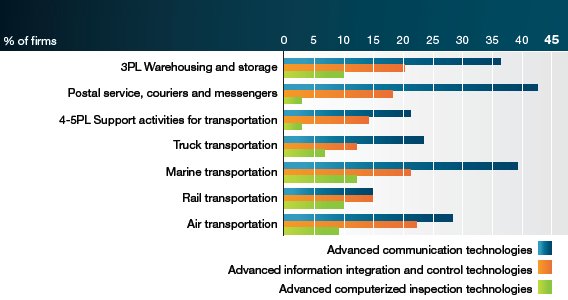
Information integration and control are the second most adopted advanced technologies. Mostsectors have an adoption rate ranging from 15 to 20 percent. Adoption rates for advanced computerizedinspection technologies vary more widely due to the nature of the specific industries (asset-basedversus non-asset-based). 4 Overall, the specific technologies implemented by logistics service providers vary by sector (Table 6).
Table 6
| Communications | Information integration and control | Computerized inspection | |
|---|---|---|---|
| 3PL Warehousing and storage | Voice recognition picking | WMS into customers' order processing | Tracking at SKU level in DC |
| Postal service, couriers and messengers | Mobile devices in delivery | ASP (application service provider) model for global visibility | Tracking at item level |
| 4-5PL Support activities for transportation | — | Linking systems with financial institutions | Near-real-time reporting e-manifest |
| Truck transportation | Mobile devices in delivery | Delivery confirmation — alert-based systems | Scanning at pick-up and delivery |
| Marine transportation | Vessel location and loading plans | Link with port and customs authority | Container seals and scanning capability |
| Rail transportation | Multimodal visibility systems | Web-based application for customers | Container seals and scanning capability |
| Air transportation | Mobile devices in airport | Link to customers' systems for visibility | Automated inspection of parcels |
The acquisition of advanced technologies calls for significant investments and may requirereorganization within a firm as well as training and a period of adjustment for management andemployees. When available, the purchase of off-the-shelf technologies is preferred and has beenthe model of acquisition selected by 74 percent of logistics and transportation firms. For over 30 percent of firms in this sector, significant modifications to an existing system often generate a solutionto address their technological needs, while 25 percent of firms opt for development of a new system(Figure 17).
Figure 17 — Acquisition model of advanced technologies by logistics and transportation service providers 4

Cloud computing has brought a new dimension to technological advancement, enabling firmsto access remotely hosted applications and data through a web interface. This removes theburden of running and maintaining applications that require frequent updates on systems thatmay quickly reach their limitations. Reducing capital expenditures is another factor in the adoptionof cloud solutions, since usage-based fees qualify as operational expenses. 2
Connecting multiple supply chain partners together is the main focus of logistics cloud solutions(licensing and leasing off-the-shelf advanced technology), notably for CPFR, global trade management, e-catalogs, visibility and traceability applications by users and logistics service providers. The majority of these specific types of applications require advanced in-house logistics applications that are connected to a web-based exchange network and are driven by large organizations. 2
Footnotes
- Footnote 12
Green supply chain management (GSCM): integrates environmental thinking into supply chain management (SCM), including the introduction of technical and innovative processes into materials sourcing and selection, delivery of the final product to consumers, and end-of-life product management. For an in-depth look at GSCM, see Industry Canada's reports on Green Supply Chain Management, available online at www.ic.gc.ca/logistics.
- Footnote 13
Warehouse management system (WMS): provides a set of computerized procedures to handle the receipt of stock and returns into a distribution facility, models and manages the logical representation of physical storage facilities (e.g. racking, etc.), manages stock within the facility, and enables a seamless link to order processing and logistics management to pick, pack and ship products out of the facility.
- Footnote 14
Transportation Management System (TMS): defines the most efficient transport plan according to given parameters such as cost, transportation mode preferences, lead time, fewer stops, carbon footprint and on-time shipments.
- Footnote 15
This is a collaborative system that looks at inventory, proposed production, order status and master schedule to determine the capability to deliver a product according to a customer's time frame, cost and location factors.
